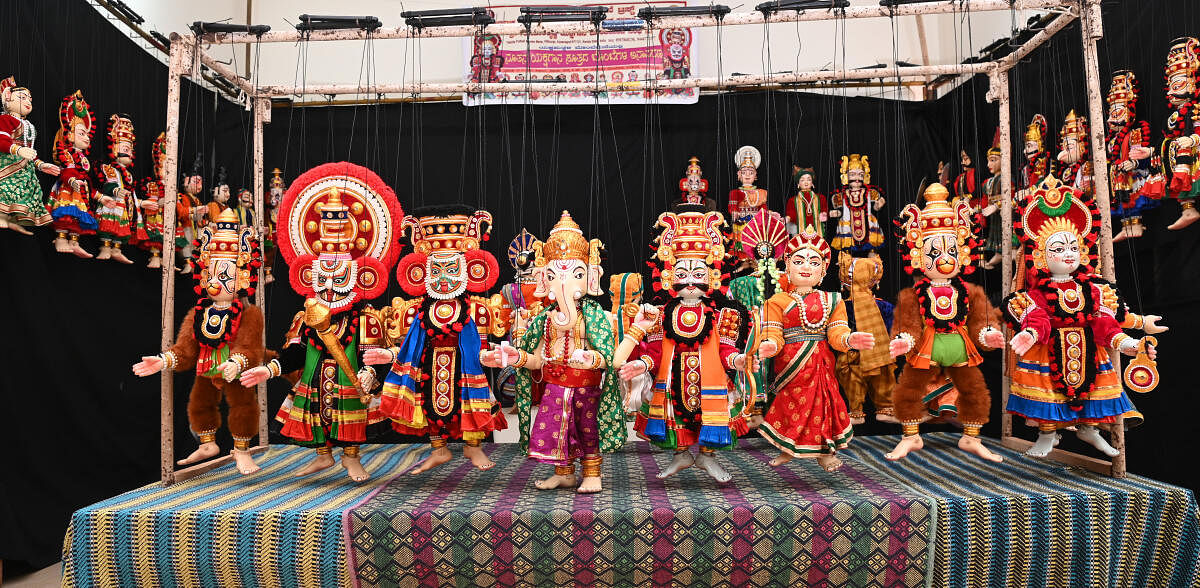
The curtains go up and Yakshagana puppets take the ‘stage’. They step to the rhythm of the pulsating music of the chende, maddale and Bhagavatha singing. The deft movements of the puppeteers begin to blur reality, bringing the inanimate Yakshagana puppets to life.
The wooden puppets, in all their rich finery, sway in perfect harmony with the music. At times, the rapt audience tends to forget that they are lifeless wooden puppets. The playful tales of Krishna, the killing of Asuras, the battle between Rama and Ravana and other stories from the epics are depicted through the Yakshagana puppetry.
String puppetry is a form of traditional Indian puppetry striving to stay afloat. The efforts of Sri Gopalakrishna Yakshagana Bombeyata Sangha in Kasaragod have gone a long way in carrying the art forward since 1981. In fact, it is the only string puppetry troupe propagating the Thenkuthittu form of Yakshagana.
With the advent of electronic media and other forms of entertainment, the demand for Yakshagana puppet shows declined drastically. There were more than 30 Yakshagana puppet troupes in undivided Dakshina Kannada 125 years ago, says director of Sri Gopalakrishna Yakshagana Bombeyata Sangha K V Ramesh. He was awarded the Karnataka Rajyotsava Award in 2010 for his expertise in string puppetry. He also won the Best Traditional Puppet Performer Award in Prague that same year.
“I was introduced to the world of string puppetry at a young age. This tradition was started by my grandfather Lakshminarayanayya and father K Venkatakrishnayya,” he says. In fact, Venkatakrishnayya’s mother Akkamma belongs to the family of Parthi Subba, who is considered one of the pioneers of Yakshagana.
Sri Gopalakrishna Sangha has held nearly 3,000 Yakshagana puppet shows in various places including Pakistan, Paris, Dubai, China and the Czech Republic.
The Yakshagana puppets’ dancing attracts viewers of all age groups. Their movements are controlled from behind the stage through strings attached to the joints of the puppets. There is a need for expert dexterity to perform the finger movements that give life to puppets on stage. “Bombeyata (puppetry) requires hard work and dedication. It is fundamental for the puppeteers to learn the rudiments of Yakshagana. They must have knowledge on thala (beat), dialogue and nrithya (dance),” Ramesh explains.
The troupe has staged about 10 to 15 different prasangas in their various performances. Some of them are ‘Panchavati’, ‘Indrajitu Kalaga’, ‘Garuda Garva Bhanga’, ‘Sri Devi Mahathme’ and ‘Narakasuravadhe’. They hope to work on ‘Lanka Dahana’ and ‘Sri Krishna Leele’ in the near future.
The puppets, the stars
The puppets are made from lightweight wood, like that derived from the ‘haale mara’ and the ‘kumbala mara’. It takes nearly three to four weeks to make one puppet.
Each of the puppets has 13 joints with six strings and three main sticks by which the strings are suspended. However, puppets of some of the characters like Narakasura and Hanumantha have seven strings. Characters like Narakasura will have a weapon in his hand while Hanumantha has a tail. As a result, an additional string is attached to these puppets.
These puppets bring a great visual appeal to the show. “All eyes remain fixed on stage. It is wonderful to watch the movements of the puppets,” says Prakash, an employee in a private firm in Mangaluru, who has watched the troupe’s shows.
The swift pace of the movements entrances others. Hrishikesh, who works in a private firm in Bengaluru, says, “Yakshagana Bombeyata entertains the audience. With its quick movements, it makes one wonder whether these puppets are real Yakshagana artistes on stage.”
For each performance, at least six to seven artistes are required to handle the puppets, depending on the Bhagavathike. A minimum of 30 puppets are used in each prasanga.
One of the puppeteers, Sudarshan from Kasargod, has been part of the troupe for the last 30 years says, “My interest in Yakshagana drew me to Bombeyata.” He points out that there is one solution to addressing the declining number of Yakshagana puppet shows: “The younger generation should develop an interest in it for the art to survive.”
To invoke an interest among the younger generation in Yakshagana puppet shows and carry forward the legacy, the troupe had organised ‘Chinnara Angalakke Puthali Yathre,’ wherein shows were performed in 30 schools in Karnataka and Kerala.
Ramesh has also been training a few people of different age groups interested in this traditional Yakshagana bombeyata.
Bhavya, a teacher by profession, is one of the students undergoing training in Yakshagana puppetry. She points out that it takes physical endurance and consistency. “When I initially started learning, my hands and legs started paining after attending two to three classes. However, I was adamant to continue it. It took nearly four years to become well-versed in one prasanga.”
A puppet house
To supplement efforts to conserve the art form, ‘Yaksha Puthali Bombe Mane’, a puppet museum has been set up to exhibit around 1,000 Yakshagana string puppets. This museum is housed at Ramesh’s residence at Pilikunje in Kasargod.
The work of making puppets carved out of teak wood is underway. Around 40 such puppets already adorn the museum. The cost of each puppet is around Rs 30,000. The puppets made of teak will last for 500 years, says Ramesh.
He also intends to stage puppet shows, set up a library, puppet-making unit as well as a puppetry training centre alongside the museum.
Noticing the initiative and the puppets, Karnataka Border Development Authority Chairman C Somashekar sanctioned Rs 20 lakh for the museum from the government in January 2023. The amount is yet to reach the Sangha, Ramesh says adding that he is hopeful that the amount will reach shortly.
